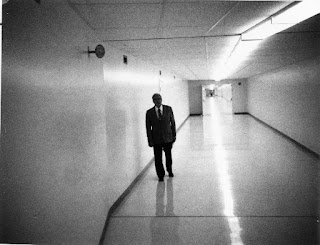To get from the V. A. Hospital to Shands Medical Center there is a long underground tunnel with white walls and a tile floor, all very shiny. Ceiling fluorescents light the way and make everything so bright, it almost hurts the eyes. It curves in some places and has a slight upward drift going to Shands. Coming back to the V.A. is easier, mostly downhill until the very end when it rises slightly.
I saw many people walking this tunnel for exercise. There is a sign on the right wall as you exit the V.A. It tells the length and how many laps you should walk, but I have forgotten those details. The tunnel goes from the basement of the V.A. to the ground floor of Shands. I never grasped why the ground floor of Shands is not called the basement since there is a 1st floor, the floor I always went to, either by elevator or stairs.
I didn’t walk the tunnel for exercise. I walked it when my husband was a patient at the V.A., which was many times before and after he had his colon removed in 2007. He had ulcerative colitis. The walls of his colon were very thin and riddled with ulcers. Several different drugs were prescribed to halt the almost constant bleeding, but nothing much helped until finally surgery became our only choice.
After his surgery, problems from not having a colon resulted in numerous hospital stays, most of them due to dehydration. If you Google “function of the colon”, absorption of fluids is the first thing on the list. When you have no colon, this becomes a big problem. If you have ever had the flu, you have a tiny idea of what dehydration is like. Jim felt this way and worse most of the time, tired, sleepy, nauseous, and dizzy. Proper nutrition with no colon requires 24/7 vigilance, and even then, things go wrong.
The tunnel was my get-away when the recliner in his hospital room became too much or when he was taken somewhere for tests or when he was sleeping. I invented reasons to walk the tunnel. I listened to music in the Shands atrium and looked at all the pictures on the walls that young patients had painted. I tried every restaurant in the food court, and when our daughter or grand children visited, we tried the Shand’s cafeteria, a hot meal for a pittance. I bought earrings, gift cards, and notebooks at the gift shop. Even the bloodmobile was a welcome diversion.
In the tunnel everyone was friendly and smiled when you met their eyes. I wondered about their stories, but the tunnel was a place to somewhere, not a rendezvous for conversation. Everyone continued on with purpose. Some of them I recognized as doctors and nurses on Jim’s floor.
When Jim felt well enough, I talked him into the wheel chair and pushed him around as long as he would let me. Sometimes we would get lunch to go at the V. A. cafeteria, and I would guide the wheelchair to an outside picnic table. Many of the grounds of the V.A. are beautiful, especially when you have been inside much too long. On the way back, I would always stop at the hospital library and pick up some new reading material.
And when the tunnel was closed at night, I roamed the V.A. halls. I joked with the nurses that I could be one of those volunteer guides, and often I did give directions to people who looked lost…and were.
But the tunnel was my favorite place to go. I felt in control. I knew exactly where I was going, and I knew what was at the end.
